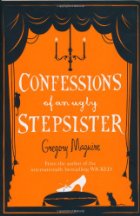‘Confessions of an Ugly Stepsister’ by Gregory Maguire
 Gregory Maguire is an author probably best known for his adaptation of The Wizard of Oz, Wicked. I’ve read the entire trilogy, with somewhat mixed results: Wicked itself I enjoyed and thought it was quite clever (although I imagine that musical is a bit less political and less bizarre than the novel, given how successful it is) but the series became increasingly strange and peculiar and much less enjoyable. A Lion Among Men was downright weird and I found it insufficiently connected to the original story of Dorothy to have much appeal. I think I like the idea of his books more than I like the books themselves, but the concept is so appealing that somehow I find myself going back for more even though they usually leave me unconvinced. It was with trepidation then that I approached his Confessions of an Ugly Stepsister, Maguire’s retelling of the classic fairy tale Cinderella. However, I was pleasantly surprised to find that this book, unlike his others that I’ve read, was a straightforward historical novel with touches of otherworldliness which worked beautifully to enhance the story rather than to make it strange and off-putting. Maguire took a familiar story and retold it in a way which made it new and interesting again, and that was exactly what I was hoping for.
Gregory Maguire is an author probably best known for his adaptation of The Wizard of Oz, Wicked. I’ve read the entire trilogy, with somewhat mixed results: Wicked itself I enjoyed and thought it was quite clever (although I imagine that musical is a bit less political and less bizarre than the novel, given how successful it is) but the series became increasingly strange and peculiar and much less enjoyable. A Lion Among Men was downright weird and I found it insufficiently connected to the original story of Dorothy to have much appeal. I think I like the idea of his books more than I like the books themselves, but the concept is so appealing that somehow I find myself going back for more even though they usually leave me unconvinced. It was with trepidation then that I approached his Confessions of an Ugly Stepsister, Maguire’s retelling of the classic fairy tale Cinderella. However, I was pleasantly surprised to find that this book, unlike his others that I’ve read, was a straightforward historical novel with touches of otherworldliness which worked beautifully to enhance the story rather than to make it strange and off-putting. Maguire took a familiar story and retold it in a way which made it new and interesting again, and that was exactly what I was hoping for.
The story is set in Holland in the 16oo’s, against the backdrop of the tulip boom. The eponymous ugly stepsister is Iris, a young girl who flees from England to Haarlem with her mother, Margarethe, and silent sister Ruth. Once there, they find the family that they expected to take them in are dead and so the family take up work as housekeepers in a painter’s studio in order to survive. When a rich businessman comes to commission a painting of Clara, his beautiful daughter, with some of his prized tulips Margarethe sees the opportunity for advancement and acts to unite her poor family with Clara’s rich one. But, as in all fairy tales, all is not entirely as it seems and plans go awry.
Often when books choose to take an alternative perspective on a well-known story it is to show that character in a more sympathetic light, so I was surprised by the very balanced way in which Maguire presents Iris and indeed all his characters. Iris is downgraded from ugly to merely plain, she cares for her disabled sister, tries to befriend Clara and is credited with intelligence, but she is headstrong (and not in the pretty, charming way that a lot of heroines are headstrong), sullen and uncooperative. Maguire hasn’t made her seem nice, he has made her seem real and believeable. Clara, the Cinderella figure, is likewise knocked down from her fairy tale princess pedestal and into the realms of mere humanity. She is beautiful and intriguing, yet on the other hand she is fey, neurotic and unable to accept things outside of her own terms. Where Cinderella’s beauty traditionally liberates her from a life of drudgery, Clara is very aware that she has very little control over her own fate in spite of her attractive appearance, something which makes the schemes of Margarethe, the wicked step-mother, seem more reasonable and justified and imbues her with a steely resolve that is more driven by self-preservation than cruelty. Ruth, the second sister, is by far the most interesting character despite playing an ostensibly minor role in the story; readers of fairy tales will know never to trust appearances and Ruth does not disappoint.
The choice to place the story in the context of the tulip mania of the 1600′s, when tulips became so popular that a single bulb could sell for more than ten times the annual wage of a skilled labourer, is a clever one. As Clara’s family soon learn to their peril, the tulips had no inherent worth and the speculation which had artifically inflated their price was all an illusion and so the setting encourages questions about true value, worth and beauty which are particularly fitting for the story. Why should Clara be considered worth more than Iris just because she is aesthetically pleasing and Iris is plain? Why is Clara’s father happy to use his shy daughter as promotional material for his business venture? Is value inherent or something subjective that the beholder or buyer adds? It definitely provides an interesting background against which to read the story of Cinderella.
Confessions of an Ugly Stepsister by Gregory Maguire. Published by Headline Review, 2008, pp. 397. Originally published 1999.